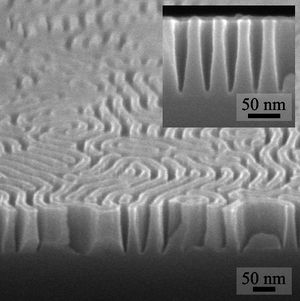Realspace
Realspace or direct-space is simply the regular 3D space that we inhabit. In scattering, it is introduced as a term to differentiate from reciprocal-space (a.k.a. inverse-space). Whereas reciprocal-space refers to the Fourier transform of the sample's structure, realspace refers to the actual structure: the electron-density spatial distribution (as imaged in SEM, TEM, AFM, STM, etc.).
Samples of scientific interest often exhibit well-defined packing in realspace, and are thus described by their lattice and/or unit cell. This gives rise to well-defined features in reciprocal-space (peaks, rings, etc.).
Contents
Realspace functions
Scattering data can be converted into a corresponding realspace representation. Normally, scattering data cannot be simply inverted (via Fourier transform) to recover the exact realspace structure. This is known as the phase problem: experiments typically record the intensity (but not phase) of scattered radiation, making unambiguous inversion impossible (note that coherent techniques, such as CDI or ptychography attempt to work around this). However, the inverse-space data of a scattering experiment can at least be converted into a statistical (or average) realspace representation. Total one-dimensional scattering can be converted into a realspace function that describes the amount of correlation across various distances
Indirect Fourier Transform (IFT)
- Glatter, O. Acta Phys. Austriaca, 1977 47, 83–102
- Glatter, O. A new method for the evaluation of small-angle scattering data J. Appl. Cryst. 1977, 10, 415–421 doi: 10.1107/S0021889877013879
- Moore, P. B. Small-angle scattering. Information content and error analysis J. Appl. Cryst. 1980, 13, 168–175 doi: 10.1107/S002188988001179X
- Svergun, D. I., Semenyuk, A. V. & Feigin, L. A. Small-angle-scattering-data treatment by the regularization method Acta Cryst. A 1988 A44, 244–250 doi: 10.1107/S0108767387011255
Pair Distribution Function (PDF)
- Porod, G. Acta Phys. Austriaca 1948, 2, 255–292.
- Billinge, S. J. L. & Thorpe, M. F. Local Structure from Diffraction, edited by S. J. L. Billinge. 1998 New York: Plenum Press.
- P. F. Peterson, M. Gutmann, Th. Proffen and S. J. L. Billinge PDFgetN: a user-friendly program to extract the total scattering structure factor and the pair distribution function from neutron powder diffraction data J. Appl. Cryst. 2000, 33, 1192 doi: 10.1107/S0021889800007123
- Kirsten M. Ø. Jensen, Anders B. Blichfeld, Sage R. Bauers, Suzannah R. Wood, Eric Dooryhée, David C. Johnson, Bo B. Iversen and Simon J. L. Billinge Demonstration of thin film pair distribution function analysis (tfPDF) for the study of local structure in amorphous and crystalline thin films IUCrJ 2015, 2 (5). doi: 10.1107/S2052252515012221
Autocorrelation Function
- Debye, P. & Bueche, A. M. Scattering by an inhomogeneous solid J. Appl. Phys. 1949, 20, 518–525 doi: 10.1063/1.1698419
Other
- Hansen, S. Estimation of chord length distributions from small-angle scattering using indirect Fourier transformation J. Appl. Cryst. 2003, 36, 1190–1196 doi: 10.1107/S0021889803014262
- C. J. Gommes, Y. Jiao, A. P. Roberts and D. Jeulin Chord-length distributions cannot generally be obtained from small-angle scattering J. Appl. Cryst. 2020, 53. doi: 10.1107/S1600576719016133
- Fritz, G. Determination of pair correlation functions of dense colloidal systems by means of indirect Fourier transformation J. Chem. Phys. 2006 124, 214707 doi: 10.1063/1.2202325
Two-dimensional
Two-dimensional scattering data can in principle also be converted into a two-dimensional realspace function. This realspace representation contains the same information, but emphasizes spatial distance correlations.
- G. Fritz-Popovski Interpretation of two-dimensional real-space functions obtained from small-angle scattering data of oriented microstructures J. Appl. Cryst. 2015, 48 doi: 10.1107/S1600576714024972
See Also
- Q value: Conversion from reciprocal-space values to realspace distances can be accomplished using

